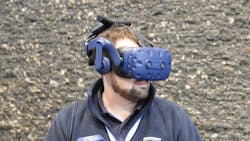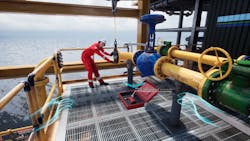Offshore Europe 2023: DNV's VR tool offers interactive training method
By Ariana Hurtado, Editor and Director of Special Reports
HOUSTON — DNV’s virtual reality (VR) tool is designed to help improve safety standards in the energy sector, and the company has used the VR technology to develop a major accident hazard (MAH) program, consisting of various scenarios where users walk through a simulated environment using hand controllers and a typical VR headset with headphones and cameras built in.
The scenarios include typical operational tasks like opening valves or erecting a scaffold, and then lead to a simulated failure, which escalates to a fire or an explosion. This technology opens up opportunities for discussions on barriers and how to respond appropriately to incidents. The "familiar setting" helps users retain important safety messages that will assist them with identifying and mitigating hazards and avoid major accidents in real life, DNV explained in a press release.
Utilizing the VR technology during industry training offers personnel an interactive method. DNV said the program offers a high level of realism, with high-quality graphics bringing to life an environment akin to an offshore facility. The technology also can help raise awareness of process safety events to offshore workers. The company says it creates an interactive learning environment that allows engaging discussions around the simulated safety violations and missed prevention opportunities observed in each of the scenarios.
"VR technology is poised to play a pivotal role in future training programs across nearly all major hazard industries and organizations with high-risk activities," John Morgan, DNV's senior principal risk advisory, Energy Systems, told Offshore. "VR has become both affordable and is already prevalent across various industries associated with high risks to people or property, signaling its potential to transform training methods. Major hazard industries, such as oil and gas, including the offshore sector, stand to benefit immensely from VR's capacity to elevate preparedness levels in high-risk environments."
In this Q&A, Morgan shares more details about the company's new VR tool and its benefits in industry training.
OFFSHORE: What is the offshore energy sector's need for this type of VR tool?
On top of this, while repetition remains vital for safety training, it can lead to monotony, whereas the element of novelty in the VR significantly contributes to effective information retention; it follows that innovative approaches often prove more successful than traditional techniques in helping people acquire new knowledge and skills.
The use of VR is such an innovative approach and has already proven effective in enhancing and maintaining workforce engagement through MAH awareness training.
OFFSHORE: How have other technologies failed to meet these training needs?
MORGAN: In safety training, relying on passive techniques can become an ineffective way to communicate crucial information. Companies should avoid a one-size-fits-all approach (usually through lectures, slides or manuals). Instead, a well-rounded training program should adopt a multi-pronged approach and incorporate a mix of formats, including videos, workshops, mentoring, demonstrations, etc. to cater to various learning styles and needs. VR technology, which offers a safe, cost-effective and interactive method with its memorable immersive 3D experiences, is one of the best possible features training programs can add to their arsenals.
In situations where hands-on testing and live demonstrations pose logistical challenges, VR offers an engaging and low-risk learning environment by immersing trainees in experiences that closely resemble real-life situations, which is particularly effective for scenarios involving forced errors and hazards, where live practice is impractical and unsafe. These VR scenarios are also interactive, with immediate feedback mechanisms that demonstrate the consequences of not following proper procedures. VR’s capacity to underscore the consequences of errors is a uniquely engaging opportunity for learners to address knowledge gaps, at no risk to their physical well-being.
These sessions also offer a great opportunity for discussions to reinforce the newly acquired information.
Overall, VR’s immersive nature creates a memorable experience, and thus enhances information retention compared to traditional training methods, making it a powerful tool for effective MAH training.
OFFSHORE: How can the technology be applied to assist operators with offshore oil and gas projects and/or developers for offshore wind projects?
MORGAN: We can already explore its potential; for instance, it is possible to conduct offshore inductions using VR before arrival to enhance hazard awareness and safety understanding.
In typical VR scenarios in fully interactive mode, DNV’s VR MAH awareness training program allows trainees to navigate a worksite using hand controllers and a headset, and interact with physical equipment such as valves and spec blinds. They engage in standard operational tasks (from checking documents to operating valves and more) and a simulated error, like a colleague dropping a scaffold pole, trigger events like loss of containment, fires or explosions.
In some scenarios, trainees have choices in how to respond, leading to different outcomes, from a hazard prevented to controlled fires or platform evacuation. The VR emphasizes realism, featuring high-quality graphics depicting pipes, vessels and equipment with details (such as rust or flaking paint) that enhance the immersion, aiding users in retaining key safety messages and risk mitigation strategies. Additionally, the VR covers hazard identification, safety and environmental critical elements (SECE) identification, IOGP process safety fundamentals (PSFs), and IOGP life-saving rules. Group discussions around hazards, SECE barriers, PSFs and lifesaving rules foster a comprehensive understanding of hazard management within each scenario.
OFFSHORE: Can you share any case study details?
MORGAN: Harbour Energy has strategically implemented DNV’s VR MAH awareness training program among its workforce to complement in-person training at DNV’s Spadeadam Research and Testing facility. VR has offered a controlled yet impactful way to expose trainees to MAH initially in the face of the limitations posed by the 2020 pandemic on in-person training and latterly outside of the UK and as a cheaper refresher, and has significantly improved MAH engagement throughout the entire company.
Following individual VR training, participants join group sessions facilitated by a training mentor, and they engage in discussions on MAH management tailored to their roles. These unscripted discussions are a rich exchange forum and foster a deeper understanding of process safety.
Harbour's adoption of VR has proven successful in creating an enjoyable learning environment, with a high demand, thanks to the technology's immersive nature. The success of the initiative was exemplified when Harbour Energy was honored with the 2022 IChemE Training and Development Award for "Fostering Process Safety Culture Through Innovation," recognizing its outstanding safety culture, facilitated by DNV’s VR program.
OFFSHORE: What's next for DNV in 2H 2023 and heading into 2024?
MORGAN: A third of the license fee is invested into improving the VR. The focus is always on keeping a user-centric approach; a proactive user group of operators with active licenses meets regularly, fostering collaboration and ideas exchange.
Recent achievements include the creation of a more interactive scenario, integration of IOGP safety rules and fundamentals, and the introduction of a SECE quiz. Looking ahead to 2024, additional improvements are in the pipeline, keeping up with evolving technology.
Editor's note: The DNV program has been adopted by 10 oil and gas operators, including Harbour Energy. DNV and Harbour presented a paper detailing how VR has made a transformative approach to MAH awareness training on Sept. 6 at the SPE Offshore Europe event in Aberdeen. The technology is being showcased at the show this week.
About the Author
Ariana Hurtado
Editor-in-Chief
With more than a decade of copy editing, project management and journalism experience, Ariana Hurtado is a seasoned managing editor born and raised in the energy capital of the world—Houston, Texas. She currently serves as editor-in-chief of Offshore, overseeing the editorial team, its content and the brand's growth from a digital perspective.
Utilizing her editorial expertise, she manages digital media for the Offshore team. She also helps create and oversee new special industry reports and revolutionizes existing supplements, while also contributing content to Offshore's magazine, newsletters and website as a copy editor and writer.
Prior to her current role, she served as Offshore's editor and director of special reports from April 2022 to December 2024. Before joining Offshore, she served as senior managing editor of publications with Hart Energy. Prior to her nearly nine years with Hart, she worked on the copy desk as a news editor at the Houston Chronicle.
She graduated magna cum laude with a bachelor's degree in journalism from the University of Houston.



